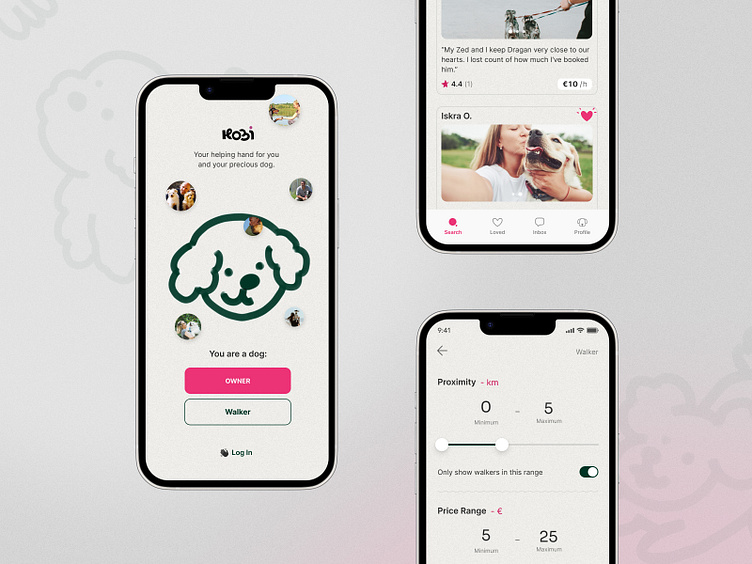Kobi: Dog-walking app
Kobi: Helping Dog owners find a trustworthy dog walker from the comfort of their homes.
- 00 Intro
So, you’re saying I don’t have to walk my dog?!
Picture: ☀️ hot summer August, you are sitting inside a cottage at the top of a Greek island trying to cool off after breakfast. Just as you’re thinking of avoiding mid-day sun, Kobi - a dog you were asked to look after- is getting nervous as she wants to be taken outside. Oh, how you wish someone else could do it for once. But, Kobi is wild and untamed, so it'll be hard to find someone patient enough.
Well, this was me thinking out loud. At that moment I had this wild idea - what if I could merge veterinary clinics with ordinary people and make them available at all times?
Technical Info
The Problem: Dog owners are in need of trustworthy walkers to look after their dogs when they are not able to.
The Goal: Build a mobile-first application that connects dog owners with verified walkers in the desired area as seamlessly as possible.
Team's Work
Affinity Diagram
Ideation
My Role
Interviews and Competitive Analysis
User flows and wireframes
High-fidelity UI designs and Prototypes
Branding and illustrations
Usability testing and Iterations
Timeline
9 weeks + full-time job
Tools
Figma | FigJam | Maze.co
- 02 Research
Sights set on discovery
My peers and I laid out some goals for conducting research before we split ways on creating our own MVPs' (for the best viewing experience, this requires a desktop or tablet) :
The Discovery
Getting to know better my audience and their needs
Having these core questions in mind, I was able to craft my own questions for potential users. Inspired by Nielsen Norman Technique “CIT”, I dove deeper into the problem. But, right at the start, I realized I was faced with a major constraint - a limited time resource. Instead of 5 participants for qualitative research, I conducted 3 one-on-one interviews with dog owners. To make up for the lack of deeper insights, I gathered all the research data from peers, and from online comments sections (Google Play, YouTube) and combined all of those as Secondary research for the best understanding.
I asked questions like:
Tell me about the last time you had to leave your dog with someone else.
If you're using an app or a service what do you like about it?
What are the most important traits you look for in someone caring for your dog?
An online survey of 11 participants gave me further insights.
Would you be interested in using an app for hiring dog walkers?
Looking closely at the YES group a new pain point was discovered: Cost. Combined with the already validated pain point of Trust I was able to focus on core problems moving forward.
🧾 Getting to know the competitors
What is the biggest setback of all the best and most used services like Wag and Rover?
Interestingly, the answers overlapped with previous quantitative research.
- 02 Defining
What exactly is the problem and who's affected by it?
I went back to the interviews and created a board with all the information I had collected in it to create a persona that will reflect all the decisions moving forward.
Robyn's Background
Robyn is commuting and works all day at the office and takes a vacation twice a year. Sometimes, Robyn gets unexpected allergies and needs to run to the doctor’s office but, worries to leave their pets unattended for long periods of time.
Robyn's Goals and Ambitions
Find trustworthy walker
Have an available walker in case of an emergency
Would love to track the route of walks
Would love to be notified with images that their dogs have started and ended a walk
Robyn's Frustrations
Burdening family and friends with their pets
Worrying that the walker will teach their dogs bad manners
Worrying if the walker actually completed the walk
Limited budget
- 03 The Approach
Simple, please!
Understanding the usage context of the app helped me shape a vision of the usability expectation of Robyn. I imagined the most seamless possible flow Robyn could have going through multiple A to B routes.
- 04 Product Thinking
Structuring the experience
The best way to conceptualize and structure the content and functionality was to craft several essential flows and wireframes for Robyn (for the best viewing experience, this requires a desktop or tablet) :
Robyn just downloaded and is opening the app
Their dog has no idea they're about to meet a new friend!
Robyn searches for that perfect walker
The limited budget makes the list of walkers skewed, but necessary for Robyn.
I can meet them free of charge?
Robyn is surprised they're not obligated to any charges all the while having the freedom to meet the walker upfront. Plus, every walker has badges of CPR and First Aid training, for Robyn's peace of mind.
- 05 Personal Challenge
Fish out of water
Coming from a graphic design background, my design decisions so far were more free-directed compared to what I’ve learned in this process. The user is both a starting and an end point of every decision. I could safely say that was my most significant finding.
The next steps I'd take would be to work on communicating/promoting a healthy lifestyle for Robyn's dog, and work on tailoring the owner’s dog’s behaviors, and (special) needs to match with the walker’s abilities.
If I were to do the project from start knowing what I know now, I'd make 1-on-1 interviews with more tailored questions, seek more participants for quantitative research for identifying patterns, as well as spend more time on competitive analysis to identify what would be the best solution for the problem. I'd work on walkers' flows and experiences and their obligatory steps like providing images of the beginning and an end of a walk to provide trust for Robyn.
























